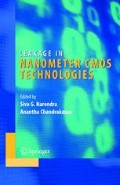Access this chapter
Tax calculation will be finalised at checkout
Purchases are for personal use only
Preview
Unable to display preview. Download preview PDF.
References
T. Mudge, “Power: A first-class architectural design constraint,” Computer, 34(4), 52–57, (2001).
T. Burd, T. Pering, A. Stratakos, and R. Broderson, “A dynamic voltage scaled microprocessor system,” IEEE J. Solid-State Circuits, 35(11), 1571–1580, (2000).
L. Clark, et al., “An embedded 32b microprocessor core for low-power and high-performance applications,” IEEE J. Solid-State Circuits, 36(11), 1599–1608 (2001).
Y. Taur and T. Ning, Fundamentals of Modern VLSI Devices (Cambridge University Press, Cambridge, UK, 1998).
N. Kim, et al., “Leakage current: Moore’s law meets static power,” Computer, 36(12), 68–75 (2003).
H. Holma and A. Toskala, eds., WCDMA for UMTS: Radio Access for Third Generation Mobile Communications, (John Wiley and Sons, NY, 2001).
M. Morrow, “Microarchitecture uses a low power core,” Computer, 36(4), 55 (April, 2001).
Intel® 80200 Processor based on Intel® XScale™ Microarchitecture Data sheet. Available at http://www.intel.com.
M. Bohr, et al., “A high performance 180 nm generation logic technology,” IEDM Tech. Dig., 197–200 (1998).
Intel® PXA255 Processor Data sheet; http://www.intel.com.
S. Wolf, Silicon Processing for the VLSI Era: Volume 3 — The Submicron MOSFET, Lattice Press, Sunset Beach, CA, 1995.
S. Mutoh, T. Douseki, Y. Matsuya, S. Shigematsu, and J. Yamada, “1-V power supply high-speed digital circuit technology with multithreshold-voltage CMOS,” IEEE J. of Solid-state Circuits, 30(6), 847–854 (1995).
L. Clark, N. Deutscher, F. Ricci, and S. Demmons, “Standby power management for a 0.18 nm microprocessor,” Proc. Int. Symp. Low Power Electronics and Design, 7–12 (2002).
B. McDaniel and L. Clark, U.S. Patent 6,166,985: “Integrated circuit low leakage power circuitry for use with an advanced CMOS process,” (2000).
K. Osada, Y. Saitoh, E. Ibe, and K. Ishibashi, “16.7 pA/cell tunnel-leakage-suppressed 16Mb SRAM for handling cosmic-ray-induced multi-errors,” Proc. Int. Solid-state Circuits Conf, 302–304 (2003).
S. Tyagi, et al. “A 130 nm generation logic technology featuring 70 nm transistors dual Vt transistors and 6 layers of Cu interconnects,” IEDM Tech. Dig., 567–570 (2000).
R. Krishnamurthy, A. Alvandpour, V. De, and S. Borkar, “High-performance and low-power challenges for sub-70nm microprocessor circuits,” IEEE Custom Int. Circuits Conf. Proc, 125–128 (2002).
L. Clark, D. McCarroll, and E. Bawolek, “Characterization and debug of reverse body bias low power modes,” Electronic Device Failure Analysis, 6(1), 13–21 (2004).
L. Clark, M. Morrow, and W. Brown, “Reverse Body Bias and Supply Collapse for Low Effective Standby Power,” IEEE Trans, on VLSI Systems, 12(9), 947–956 (2004).
S. Zhao, et al., “Transistor optimization for leakage power management in a 65 nm CMOS technology for wireless and mobile applications,” VLSI Symp. Tech. Dig., 1–15 (2004).
S. Shigematsu, S. Mutoh, Y. Matsuya, Y. Tanabe, and J. Yamada, “A 1-V High-speed MTCMOS Circuit Scheme for Power-Down Application Circuits,” IEEE Journal of Solid-state Circuits, 32(6), 861–870 (1997).
L. Clark and F. Ricci, US Patent #6,639,827: “Low Standby Power using Shadow Storage,” 10/28/03.
L. Clark, R. Patel, and T. Beatty, “Managing Standby and Active Mode Leakage Power in Deep Sub-micron Design,” Proc. Int. Symp. Low Power Electronics and Design, 274–279 (2004).
Author information
Authors and Affiliations
Rights and permissions
Copyright information
© 2006 Springer Science+Business Media, Inc.
About this chapter
Cite this chapter
Clark, L. (2006). Case Study: Leakage Reduction in the Intel Xscale Microprocessor. In: Leakage in Nanometer CMOS Technologies. Series on Integrated Circuits and Systems. Springer, Boston, MA. https://doi.org/10.1007/0-387-28133-9_11
Download citation
DOI: https://doi.org/10.1007/0-387-28133-9_11
Publisher Name: Springer, Boston, MA
Print ISBN: 978-0-387-25737-2
Online ISBN: 978-0-387-28133-9
eBook Packages: EngineeringEngineering (R0)

